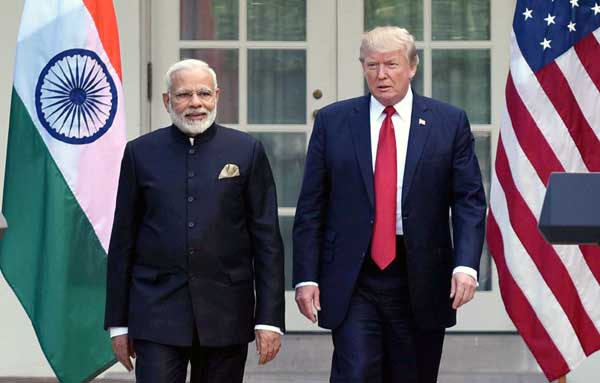IDR Blog
India's emerging power play in the Indo-Pacific

Is the Indo-Pacific a new strategic imperative for India? It is marked by a precarious geometry of faultlines and strategic mistrust and could be the centre of the next ‘Great Game.’ Indian policy makers are redefining India’s strategic autonomy as an objective that is attainable through strengthened partnerships. After Independence, India shied away from alliances and asserted its non-aligned status. Is India finally moving towards a more ‘aligned’ foreign policy in line with its interests as an ‘Emerging Power’?
In 2015, then Foreign Secretary S. Jaishankar suggested India “aspire[s] to be a leading power, rather than just a balancing power and India was willing to shoulder greater global responsibilities.” Confirming this significant shift, current Foreign Secretary Vijay Gokhale asserted during the January 2019 ‘Raisina Dialogue’: “India has moved on from its non-aligned past. India is today an aligned state — but based on issues.” Underscoring that it was time that India becomes part of the rule-making process, Gokhale argued: “In the rules-based order, India would have a stronger position in multilateral institutions.” He was categorical that India’s future would be largely shaped by the kind of role New Delhi manages to play in the G-20 and the Indo-Pacific, signalling India’s changing priorities.
The acknowledgement that American presence in the region was in India’s larger strategic interests marked a significant shift from old mantras. Jaishankar had candidly suggested: “From an Indian perspective today, for us the fact that the US is both a source of supply and a military partner helps to create enough uncertainties that could actually strengthen security in the Indo-Pacific region.” As the balance of power in the Indo-Pacific undergoes a dramatic shift, India’s assessment of this balance will be crucial to preserving its strategic balance in this vortex of shifting power balances.
India today is involved in several strategic partnerships, with the US partnership dominating its foreign policy imperatives. What adds complexity to the process is China’s push for greater influence in the Indo-Pacific and the belated recognition of its consequences by major powers, notably USA, EU, Japan, Australia and India. When India engages within the so-called “Quad”, it enhances its strategic autonomy vis-à-vis China.
These changes were inevitable. Prime Minister Narendra Modi underscores the confidence of an aspirational society willing to reassert its civilisational soft power. This transition has imbued Indian foreign policy with a certain amount of risk-taking, unlike the risk aversion of the past. India, from perpetually being a cautious power, is seemingly ready to take on a larger global role by being more nimble in playing the great power game.
The Quad first emerged as a cooperative response to the devastation of the 2004 tsunami, with the navies of India, Australia, Japan, and the US engaged in delivery of humanitarian and disaster relief. In 2007, Japan’s Prime Minister Shinzo Abe, an early advocate of the Indo-Pacific, took steps to formalise the grouping through an initial summit and joint naval exercises in the Bay of Bengal. Despite Abe’s efforts, the Quad failed to integrate as a formal group after Australia withdrew in 2008 over concerns that the group might antagonise China.
A complex web of interwoven bilateral and trilateral security links sustained a loose coalition between the four nations, allowing reconstitution some ten years later in a format that some have labelled “Quad 2.0.” Strategic analysts like Dr. Harsh Pant underline that this shift in the epicentre of global politics from the trans-Atlantic to the Indo-Pacific, marked by America’s relative decline and the rise of China has significant geopolitical implications for the region. The idea was revived in 2017 with former US Secretary of State Rex Tillerson pitching for “greater engagement and cooperation” among democratic powers.
In November 2017, on the sidelines of the 12th East Asia Summit in Manila, Philippines, the Quadrilateral arrangement saw a dramatic revival. China’s aggressive behaviour over the last decade led to the revival of the Quad 2.0 due to rising concerns at China’s hegemonic designs in its neighborhood. The Quad also had several reservations on BRI. The Quad felt that the scale and scope of the Chinese economic footprint could be tackled if they combined forces. United by their uneasiness at the rise of a militant and aggressive China, the four are working to establish a joint regional infrastructure scheme as an alternative to China’s Belt and Road Initiative (BRI).
The Quad emphasizes their commitment to the ‘rules-based order’. The rules for engagement however, are yet to be fully established. Several actionable issue areas like piracy could be considered. The US Indo-Pacific Command could use drones for monitoring major trade routes and facilitate real-time information exchange with ASEAN countries like Indonesia, Philippines, Malaysia, and Singapore. It should focus on building a robust regional consultation mechanism.
US emphasis on the Indo-Pacific brought the concept to the fore of analysis and scrutiny across the region. Nations sought to define their own Indo-Pacific perspectives. It dominated the agenda and discussion at Delhi’s Raisina Dialogue in early 2018 and at Singapore’s Shangri La Dialogue. Australia, Japan, and India have welcomed the attention that President Trump gave to the concept.
The November 2018 meeting of Quad countries on the sidelines of 13th East Asian Summit in Singapore, along with Trump Administration’s emphasis on a free and open Indo-Pacific strategy, focussed attention on the future viability of this grouping. As a strategic concept, the Quad was evolving into an important strategic grouping to promote rule-based, open and free and inclusive Indo-Pacific. US National Security Adviser John Bolton, noted: “This is a strategy that is still being shaped and the level of diplomatic activity has picked up.”
India has now emerged as a major player in the Indo-Pacific. The United States’ renaming of the Hawaii-based US Pacific Command (USPACOM) as US Indo-Pacific Command (USIPACOM) followed by Trump administration’s repeated use of the phrase “Indo-Pacific” in tandem with the geopolitical realities has brought India to the centre-stage of this geopolitical churn. This has led India to engage proactively with the United States and other major global powers like Japan and Australia in envisioning the Indo-Pacific order.
India is fully aware of the high stakes in this new ‘Great Game’. Given its unsettled border with China and the Doklam crisis, India is engaged in a careful balancing act. There is also a problem of defining and agreeing upon the geographical boundaries of the Indo-Pacific. India regards Pakistan as a troubled littoral of the Indo-Pacific, just like the United States views North Korea. The Quad framework derives its geopolitical validation from India’s association and presents a unique opportunity for India to be an active participant in shaping regional security architecture with global undertones.
In line with his new foreign policy imperatives, PM Modi has promoted the Indo-Pacific as a framework that aligns to his ‘Act East’ and ‘Neighbourhood First’ policies. India’s own geopolitical positioning is complex. His speech at Shangri-La Dialogue in 2018 described the Indo-Pacific as a “natural region” extending from the “shores of Africa to that of America,” even as he downplayed the idea of the “Indo-Pacific” as any sort of strategy or an exclusive club. He underlined a “free, open and transparent Indo-Pacific grounded in respect for international maritime laws.”
India is integral to USA’s shift towards the Indo-Pacific. Strategic manoeuvring nevertheless continues. Some analysts note India is “exercising strategic caution”. Having recently engaged in their third official-level meeting, it is clear that each of the US’ key Indo-Pacific partners — Japan, Australia, and India — are generally supportive of an informal coalition of the Quad finding common agreement in the need to promote a rules-based, open, free, and inclusive Indo-Pacific.
India is crucial to USA’s Indo-Pacific policy demonstrating how strategic parameters of Indian foreign policy have shifted under PM Modi. It has resulted in a hyper-energetic diplomacy that seeks an ever-greater global footprint. This transition is driven by an ambition to be a rule-maker, not merely a rule-taker. As Pant notes: “It has imbued Indian foreign policy with a certain amount of risk-taking, unlike the risk aversion of the past. India, from perpetually being a cautious power, is seemingly ready to take on a larger global role by being more nimble than ever in playing the great power game.”
India is charting new territory in its foreign policy. Indian foreign policy has shifted the goal posts in the last five years — both in style and substance. Nowhere is this more evident than in the Indo-Pacific. With so many new and emerging threats to international peace and security including in the Indo-Pacific, the new global narrative on security would depend on how emerging powers like India responds to this changed scenario. Given its difficult neighbourhood, a militaristic China and a fundamentalist and nuclear-armed Pakistan, a timely response is the need of the hour. There is no other option for India.
Courtesy: https://southasiamonitor.org/news/india-s-emerging-powerplay-in-the-indo-pacific/sl/29011




